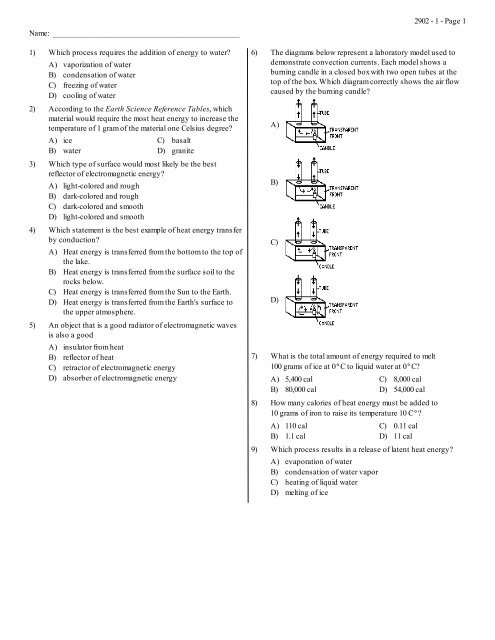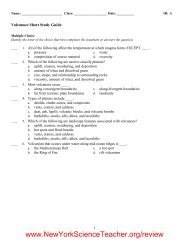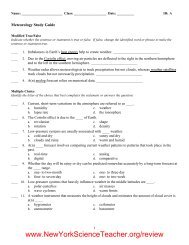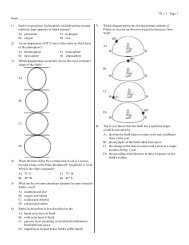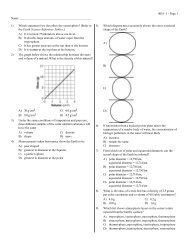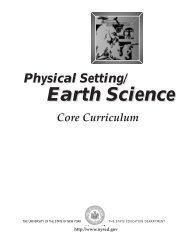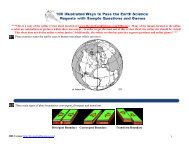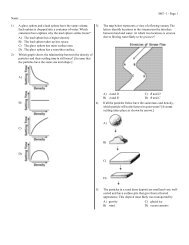63 questions - Earth Science Regents Review
63 questions - Earth Science Regents Review
63 questions - Earth Science Regents Review
You also want an ePaper? Increase the reach of your titles
YUMPU automatically turns print PDFs into web optimized ePapers that Google loves.
10) The diagram below shows temperature values at variouspoint in a solid piece of aluminum. Toward which point willheat flow from point P?A) D B) B C) C D) AQuestions 11 through 15 refer to the following:The graph below shows the temperatures recorded when a sampleof water was heated at a constant rate from -50DC to 100DC duringa 20-minute period.11) The greatest amount of energy is required to heat thesample from pointA) A to point BB) D to point EC) C to point DD) B to point C12) How many calories of heat would be used to change thetemperature of 20 grams of the water from the temperature atpoint C to the temperature at point D?A) 200 caloriesB) 540 caloriesC) 800 caloriesD) 2,000 calories13) The water temperature reached 65DC after the sample hadbeen heated for approximately how many minutes?A) 9 minB) 5 minC) 7 minD) 3 min14) Between which points was the temperature changing at thegreatest rate?A) C and DB) B and CC) D and ED) A and B15) Between points D and E the water most likely wasA) vaporizingB) condensingC) meltingD) freezing16) Which energy transformation occurs as a rock falls freelyfrom the top of a vertical cliff?A) The rock's potential energy and kinetic energydecrease.B) The rock's potential energy increases and the rock'skinetic energy decreases.C) The rock's potential energy and kinetic energy increase.D) The rock's potential energy decreases and the rock'skinetic energy increases.17) Which characteristics of a material have the greatest effecton the amount of insolation that the material will absorb?A) density and hardnessB) roughness and colorC) age and roughnessD) hardness and age18) How much heat energy is required to raise the temperatureof 10. grams of granite from 20.DC to 50.DC?A) 500 calB) 57 calC) 1.9 calD) 300 cal19) An object was added to a beaker of water. Using athermometer, a student observed an immediate increase inwater temperature. What is the best interpretation of thisobservation?A) The object was an energy source to the water and tothe thermometer.B) The thermometer was an energy sink to the water, butan energy source to the object.C) The object and the thermometer were energy sinks tothe water.D) The object was an energy sink to the water, but anenergy source to the thermometer.20) A sample of water undergoes the phase changes from ice tovapor and back to ice as shown in the model below. Duringwhich phase change does the sample gain the greatestamount of energy?A) D B) A C) B D) C21) According to the heat energy formula in the <strong>Earth</strong> <strong>Science</strong>Reference Tables, how many calories of heat energy mustbe added to 20 grams of cold water to raise its temperature5DC?A) 120 caloriesB) 100 caloriesC) 20 caloriesD) 4 calories2902 - 1 - Page 2
22) The diagram below represents a large beaker of water beingheated to demonstrate convection.2902 - 1 - Page 327) The diagram shows a container of water that is beingheated. The movement of water shown by the arrows ismost likely caused byThe movement of water upward from A toward B resultsprimarily fromA) capillary action within the waterB) air movement across the surface of the waterC) the shape of the beakerD) differences in density in the water23) Infrared, ultraviolet, and visible light are all part of the solarspectrum. The basic difference between them is theirA) wavelengthB) sourceC) temperatureD) speed24) How much heat energy will be lost by a 200-gram mass ofwater as it cools from 40DC to 35DC?A) 108,000 calB) 16,000 calC) 205 calD) 1,000 cal25) Which example of heat transfer is due mainly to convection?A) heat energy transferred by air moving from the <strong>Earth</strong>'ssurface to the upper atmosphereB) heat energy transferred through a solid metal doorC) heat energy transferred from the Sun to the <strong>Earth</strong>D) heat energy transferred by being reflected from a lakesurface to the air above26) If equal masses of water in various phases (states) arecompared, which phase will contain the greatest amount ofstored energy (latent heat)?A) solid iceB) water vaporC) liquid waterA) the <strong>Earth</strong>'s rotationB) insolationC) the Coriolis effectD) density difference28) The diagram below illustrates equipment used to perform anopen-system heat transfer investigation under ordinaryclassroom conditions.If the initial temperature of the cold water was 10DC and theinitial temperature of the hot water was 86DC, what were themost likely temperature readings after 12 minutes?A) 4DC for the cold water and 92DC for the hot waterB) 22DC for the cold water and 74DC for the hot waterC) 6DC for the cold water and 82DC for the hot waterD) 16DC for the cold water and 74DC for the hot water29) How many calories of latent heat would have to beabsorbed by 100 grams of liquid water at 100DC in order tochange all of the liquid water into water vapor at 100DC?A) 8,000 calB) 54,000 calC) 100 calD) 1,000 cal
30) The diagram below illustrates equipment used to perform anopen-system heat transfer investigation under ordinaryclassroom conditions.The greatest amount of heat energy transferred between thehot and cold water is transferred by the process ofA) radiationB) absorptionC) convectionD) conduction31) At which temperature will iron radiate the leastelectromagnetic energy?A) 0DCC) 32DFB) 230 KD) 0DF32) Which material would require the greatest amount of heatenergy to raise its temperature from 5DC to 10DC? [Refer tothe <strong>Earth</strong> <strong>Science</strong> Reference Tables.]A) 10 g of ironB) 10 g of leadC) 10 g of graniteD) 10 g of dry air2902 - 1 - Page 433) Two insulated cups are connected by an aluminum bar. Coldwater is placed in one cup and an equal mass of hot water isplaced in the other cup. The temperature of the hot waterdecreases more rapidly than the temperature of the coldwater increases. Which statement best explains thisobservation?A) Hot water has a lower specific heat than cold water.B) Some heat passes from the aluminum bar to the air.C) The cold water is undergoing a change of phase.D) The cold water gains heat from the air.Questions 34 through 37 refer to the following:The diagram below shows equal masses of four different earth materials at different temperatures.34) Convection currents may be produced most easily in thesamples ofA) iron and dry airB) granite and ironC) water and dry airD) water and granite35) If 100 calories of heat is added to each sample, the smallestchange in temperature will occur in theA) ironB) dry airC) graniteD) water36) Which statement best describes the relationship between aheat sink and a heat source if the samples are placed incontact with each other?A) The granite will be a heat source for the dry air.B) The water will be a heat sink for the iron.C) The dry air will be a heat source for the water.D) The iron will be a heat sink for the granite.37) How much heat is needed to raise the temperature of theiron sample to 30DC?A) 30 calB) 33 calC) 11 calD) 22 cal
41) With reference to diagram I, which graph best representsthe change in temperature during the first 10 minutes afterthe light source is turned on?2902 - 1 - Page 6A)B)C)D)
Questions 42 through 46 refer to the following:2902 - 1 - Page 7The diagram below represents a closed energy system consisting of air and equal masses of copper, granite, and water in a perfectlyinsulated container. The temperatures were taken at the time the materials were placed inside the closed system.42) As time passes, the total energy in the system willA) increaseB) decreaseC) remain the same43) Which material in the energy system has the highestspecific heat?A) copperB) graniteC) waterD) dry air44) The mass of the granite is 2,000 grams. How much heatwould have to be added to raise its temperature 20 CD?A) 5,400 calB) 4,000 calC) 7,600 calD) 76 cal45) In the first day after the materials were placed in the system,the temperature of the water would probablyA) increaseB) decreaseC) remain the same46) In this system, which material is a heat sink for anothermaterial?A) The granite is a heat sink for the water.B) The copper is a heat sink for the granite.C) The copper is a heat sink for the air.D) The water is a heat sink for the air.Questions 47 through 50 refer to the following:The graph below indicates the temperatures recorded when a sample of water was heated from -100DC to 200DC. The water received thesame amount of heat every minute.
47) At which point in time would most of the water be in theliquid phase?A) 16 minutesB) 14 minutesC) 1 minuteD) 4 minutes48) For the time on the graph represented by the line frompoint B to point C, the water wasA) condensingB) freezingC) meltingD) boiling49) The greatest amount of energy was absorbed by the waterbetween pointsA) D and EB) B and CC) C and DD) A and B50) How many calories were required to change 10. grams ofliquid water at point D to water vapor at point E?A) 800 calB) 500 calC) 1,000 calD) 5,400 cal2902 - 1 - Page 851) The diagram below shows part of the electromagnetic spectrum.Which form of electromagnetic energy shown on the diagram has the lowest frequency and longest wavelength?A) gamma rays B) red light C) AM radio D) infrared raysQuestions 52 through 54 refer to the following:The diagram below represents a hot-air solar collector consisting of a wooden box frame, an absorber plate, a glass cover, andinsulation.
52) Which paint should be used on the absorber plate if it isdesigned to absorb the greatest possible amount ofinsolation?A) white paintB) black paintC) yellow paintD) red paint53) Why does the air usually enter the collector at the lower airinlet and leave the collector at the upper air outlet?A) The air inside the collector is less dense than the air inthe lower air inlet.B) The air inside the collector is cooler than the air in thelower inlet.C) The air inside the collector has less moisture than theair in the lower air inlet.D) The mass of the air inside the collector is greater thanthe mass of the air in the lower inlet.2902 - 1 - Page 954) The main purpose of the insulation behind the absorberplate is toA) decrease the amount of energy lost through the back ofthe collectorB) increase the amount of energy reflected by the absorberplateC) decrease the amount of energy received by thecollectorD) increase the rate of energy transfer through theabsorber plateQuestions 55 through 58 refer to the following:In the diagram below, equal masses of water and soil are located at identical distances from the lamp. Both were heated for ten minutesand then the lamp was removed. The water and soil were then allowed to cool for ten minutes. The graph shows the temperature dataobtained during the investigation.55) By which process was most of the energy transferredbetween the lamp and the water during the first 10 minutesof the investigation?A) convectionB) reflectionC) radiationD) conduction56) What were the temperature readings of the water and soil atthe time the lamp was turned off?A) The water was 45DC and the soil was 28DC.B) The water was 20DC and the soil was 20DC.C) The water was 23DC and the soil was 30DC.D) The water was 28DC and the soil was 45DC.57) Compared to the water, the soil became warmer during theheating period because the soilA) was closer to the lampB) reradiated less heatC) has a lower densityD) has a lower specific heat58) What was the rate at which the soil temperature changedduring the first ten minutes of the investigation?A) 25 CD/minC) 8 CD/minB) 2.5 CD/minD) 0.8 CD/min


